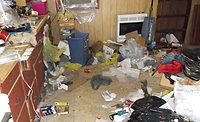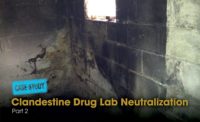The hit AMC TV series, “Breaking Bad,” gave us a glimpse inside a methamphetamine cook’s world. The main character, Walter White, was a chemistry teacher turned drug kingpin who turned to cooking meth to support his family and pay for expensive cancer treatments. White’s actions eventually led to his own demise, but the death and destruction left in his wake was telling.
Probably the most disturbing takeaway was the realization that a meth lab can exist just about anywhere - in a moving car, in a basement, in a stolen Winnebago or even in a state-of-the-art underground laboratory beneath an industrial laundry facility.
So who is responsible for identifying and cleaning up the Meth?
Related Reading
Let’s Talk About Meth
According to the U.S. Drug Enforcement Administration’s Methamphetamine Lab Incidents list there were 11,210 clandestine laboratory incidents in 2012. This is down from 13,390 in 2011. Missouri leads the country at 1,825 incidents. Right behind is Tennessee at 1,585 and Indiana at 1,429. New York, California and Texas report 147, 79, and 32 busts respectively.
But these numbers can be deceiving.
Some methamphetamine labs literally go up in flames as fires and explosions are telltale signs of chemistry gone bad. However, most go undetected by police. In reality, law enforcement busts only a fraction of clandestine laboratories. So what happens to undetected labs and what are the procedures for identifying contamination and cleaning the structures so they are safe for re-occupancy?
This first step is identifying the danger. Here are some things to watch for before entering a suspect structure:
- Police Activity
- Pungent Odors
- Unkempt Property
- Empty Chemical Containers:
- The DEA
Know the Dangers
Before the cleanup process can begin, it is important to know the dangers of possible worker exposure. Meth labs are highly toxic chemical mine fields. Fire and explosions pose an immediate risk due to the volatile compounds used in production. Entering a meth lab before proper assessment by law enforcement or before proper testing and cleaning can cause symptoms ranging from coughing, nausea and dizziness, to chemical burns and even death. Routes of exposure from meth lab chemicals occur thorough inhalation, absorption or through direct skin contact and ingestion.
Besides the chemical dangers surrounding a meth lab, there is also the danger of booby traps intended to protect inventory. Emergency responders report finding gasoline-filled light bulbs that ignite with a flip of the switch, hidden trip wires connected to tear gas grenades and even explosive devices packed with broken glass. Take extreme caution when working in or around a known lab.
Who Regulates Meth Cleanup?
The Environmental Protection Agency (EPA) does not officially regulate the cleanup of meth labs but does provide Meth Lab Cleanup Guidelines for reference. Every state has an independent procedural and clearance mandate for re-occupancy. Links to state regulatory data can be found in the appendix of the Meth Lab Cleanup Guidelines.
Cleaning up the Meth: A 12-Step Process
-
Step 1: Secure the Property: If a structure is suspect, do not enter the building. Instead, allow local law enforcement and first responder hazmat teams to remove toxic and hazardous drug paraphernalia and chemicals. After this is complete, the testing and remediation process can begin. Personnel who enter a former meth lab should have safety and health training. Appropriate personal protective equipment (PPE) such as eye glasses, heavy gloves, foot coverings, steel-toe boots and long-sleeved coveralls or a disposable protective suit must be worn.
-
Step 2: Ventilate: Air out meth labs with fresh, outdoor air by opening doors and windows and using blowers and/or a negative air unit with HEPA filtration before, during and after the remediation process. HVAC systems should be completely shut down before and during the remediation process to avoid re-contamination.
-
Step 3: Assess & Test, Scope of Work: Why do pre-remediation sampling? Pre-remediation sampling can reduce costs by streamlining the cleanup process and identifying materials that are too contaminated to clean. Pre-remediation sampling also can be useful in identifying uncontaminated areas. An industrial hygienist with the proper certifications should perform sampling. All rooms serviced by HVAC systems should be considered for testing. Pre-remediation testing is important for many reasons. It can ensure safety of workers and levels of PPE necessary. It establishes whether or not contamination levels exceed state and local requirements and if remediation is necessary. Sampling can also show the reach of the contamination and present a scope of work for remediation contractors for developing cost estimates. It can also highlight other hazardous materials relevant to the reconstruction process.
-
Step 4: Develop a Cleanup Plan: Use the scope of work provided by the environmental consultant to formulate a plan for cleanup. The plan should show security concerns, status of utilities on site, levels of PPE for workers and a shoring plan if structural integrity is an issue. Outline cleanup methods including removal vs. cleaning, encapsulations if any and procedures for on-site and off-site contamination including a waste disposal plan.
-
Step 5: Remove Contaminated Materials: The EPA suggests gross removal followed by 24 hours of ventilation and removal of all meth paraphernalia. This is when the determination is made to clean or discard contents.
-
Step 6: Vacuum: Vacuum the floors with a commercial-grade vacuum with a HEPA filter after carpet removal. Standard canister or non-commercial grade vacuums are not recommended. In addition, vacuum walls to remove dirt and cobwebs prior to washing. This will remove particulate contamination but will not remove contamination entirely.
-
Step 7: Preliminary Washing of Hard Surfaces: After items have been removed and vacuumed, wash walls and hard surfaces using a detergent water solution. This helps prevents re-contamination during the remediation process. Bleach should not be used in the cleaning process as the reaction between bleach and the chemicals used in producing meth can create a toxic gas. Consider testing wash water to determine if it qualifies as hazardous waste or can be disposed of onsite.
-
Step 8: Clean and Seal HVAC System: Shut down the HVAC system immediately and leave it off during the remediation process. Sample all areas and rooms serviced by the system to determine the spread of contamination. Test ducts to determine scope of contamination. Cleaning can be difficult as many times duct work can be porous and can re-contaminate the structure after remediation is complete. Cleaning methods should be left to the discretion of ventilation contractors but experts agree that no chemicals should be added to disinfect ducts.
-
Step 9: Thorough Detergent Water Washing: Use a household all-purpose cleaner, follow manufacturer concentration guidelines and start with the ceilings, walls and finish with floors. Clean other hard-surfaced items like counters and furniture. Clean the entire surface using either hot or cold water and repeat each wash with a thorough rinse using clean water and a clean cloth. The use of harsh chemicals is not advised as many of the pre-cursor chemicals used in meth production can have adverse chemical reactions. Bleach, for example, can become very toxic.
-
Step 10: Consider Encapsulating Walls & Ceilings: Sealing contaminated walls and surfaced with primers and paint can provide a protective barrier but should be done in conjunction with proper cleaning techniques. Several states recommend that products applied to encapsulate surfaces be sprayed on and not hand-rolled.
-
Step 11: Flush Plumbing & Septic Systems: Meth chemicals are frequently poured into sink drains and flushed down toilets. As a result, plumbing systems can be compromised via corrosion or even become flammable. Flush plumbing traps with generous amounts of water during the cleaning process and again after remediation if wash water is disposed of on site. Sinks, bathtubs and toilets with visible discoloration and etching should be disposed of. Large amounts of chemical waste can be problematic if they remain in septic systems or private wastewater systems. If there is evidence of contamination, an industrial hygienist should sample the tank for volatile organic compounds (VOCs) and/or pH levels outside the normal range. Expert field screening should be used to evaluate septic system contamination. Remediation of septic systems should be done last.
- Step 12: Clearance Testing: It is very important to show that cleanup effectively reduced contamination. Check with local governments to determine re-occupancy clearance levels. If cleaning does not meet the state standard, the site should be cleaned again or encapsulation or removal should be considered.
Removing Contaminated Materials
Consider the following:
- Potential for human contact: Take extra care with children’s items: Frequent hand to mouth contact, higher metabolic system and developing nervous system make children more vulnerable to toxic chemicals.
- Intrinsic or emotional value of irreplaceable items and photos.
- Porosity: Porous items are much more difficult to clean and are often discarded.
- Hazardous or non-hazardous waste disposal? Meth lab waste cannot go in landfills, according to the Resource Conservation and Recovery Act (RCRA).
- Follow asbestos and lead disposal guidelines.







Report Abusive Comment